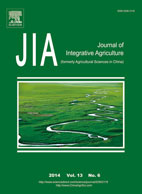|
|
Research on Spatial-Temporal Characteristics and Driving Factor of Agricultural Carbon Emissions in China
TIAN Yun, ZHANG Jun-biao, HE Ya-ya
2014, 13(6):
1393-1403.
DOI: 10.1016/S2095-3119(13)60624-3
Macroscopic grasp of agricultural carbon emissions status, spatial-temporal characteristics as well as driving factors are the basic premise in further research on China’s agricultural carbon emissions. Based on 23 kinds of major carbon emission sources including agricultural materials inputs, paddy field, soil and livestock breeding, this paper firstly calculated agricultural carbon emissions from 1995 to 2010, as well as 31 provinces and cities in 2010 in China. We then made a decomposed analysis to the driving factors of carbon emissions with logarithmic mean Divisia index (LMDI) model. The results show: (1) The amount of agricultural carbon emissions is 291.1691 million t in 2010. Compared with 249.5239 million t in 1995, it increased by 16.69%, in which, agricultural materials inputs, paddy field, soil, enteric fermentation, and manure management accounted for 33.59, 22.03, 7.46, 17.53 and 19.39% of total agricultural carbon emissions, respectively. Although the amount exist ups and downs, it shows an overall trend of cyclical rise; (2) There is an obvious difference among regions: the amount of agricultural carbon emissions from top ten zones account for 56.68%, while 9.84 % from last 10 zones. The traditional agricultural provinces, especially the major crop production areas are the main source regions. Based on the differences of carbon emission rations, 31 provinces and cities are divided into five types, namely agricultural materials dominant type, paddy field dominant type, enteric fermentation dominant type, composite factors dominant type and balanced type. The agricultural carbon emissions intensity in west of China is the highest, followed by the central region, and the east zone is the lowest; (3) Compared with 1995, efficiency, labor and structure factors cut down carbon emissions by 65.78, 27.51 and 3.19%, respectively; while economy factor increase carbon emissions by 113.16%.
|
